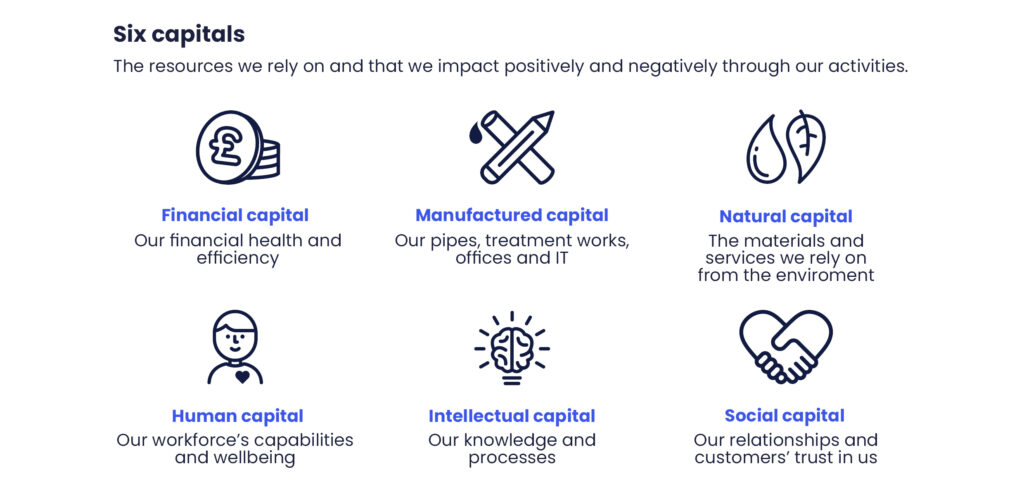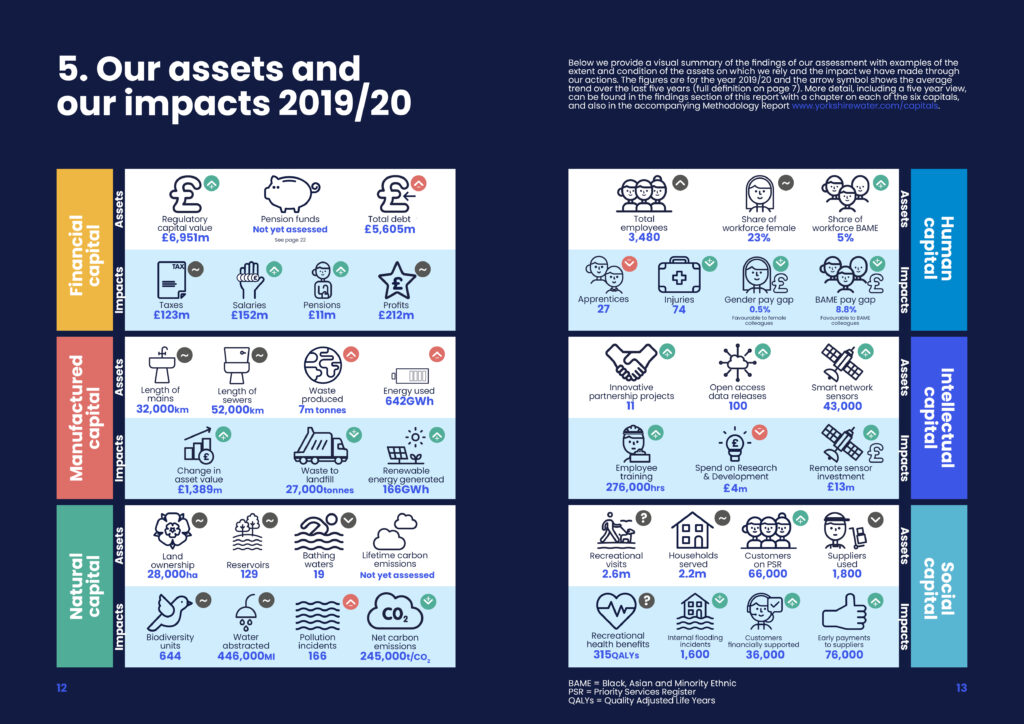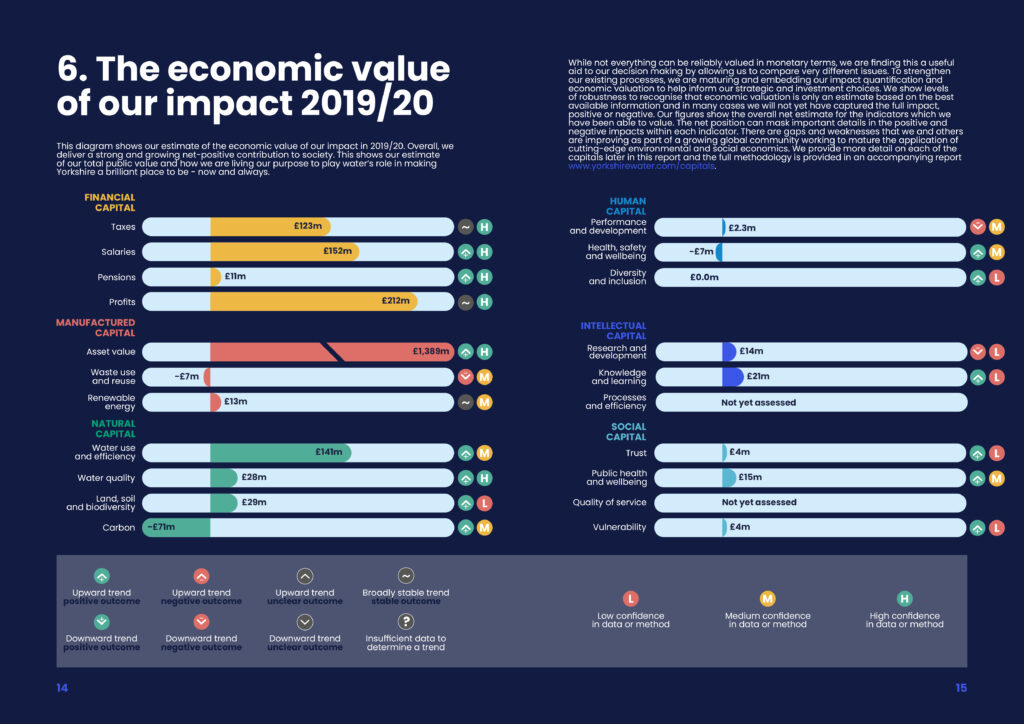The organization in brief:
Yorkshire Water is a regulated water and wastewater company, serving over 5 million people and 130,000 businesses in the north of England. We provide some of life’s most essential services and play a key role in the region’s health, wellbeing, and prosperity. We are passionate about delivering great value, both in the quality of our services and through the choices we make to maximise our wider social impact.
Why was this undertaken?
To provide water and wastewater services reliably, now and in the future, sustainability must be at the heart of how Yorkshire Water operates. In 2015 we adopted a capitals approach to underpin our corporate strategy and allow us to better understand – and therefore better manage – the economic, environmental, and social impacts of our actions. We completed an initial total impact and valuation assessment (TIVA) for 2014/15. This year we completed a second assessment, covering the period from 2015 to 2020, in which we aimed to understand how our impacts have changed since our first report.
The capitals approach is shaping our thinking and investments to help us focus on what really matters. Expanding our understanding of risk and value helps us to identify key impacts and dependencies and drive more informed and sustainably focused decision making. The knowledge gained from our TIVA assessment increases our business efficiency and resilience, and will ensure we continue to protect and grow the public value we create for customers, investors, and other stakeholders.
What was the scope?
We used a multi-capitals approach in our TIVA assessment that covered the following six capitals: financial, manufactured, natural, human, intellectual, and social. For each capital we focused on assessing asset stocks and their condition, as well as the annual impacts (both positive and negative) of our business activities on these assets. Where possible we also estimated the economic value of our impacts to our business and society. Our assessment covered 2015 to 2020, which allowed us to assess trends in annual performance over the five-year period.
The scope of our assessment included the activities directly undertaken by Yorkshire Water because this is where we are most able to deliver change and where we had best available data. With a few exceptions, we excluded activities carried out in Yorkshire Water’s supply chain or by others in the Kelda Group of companies of which Yorkshire Water is the largest. In the future we aim to extend the scope to our supply chain and value chain once we have further embedded and matured our approach to assessing direct impacts.

How did you measure and value your impacts and/or dependencies?
Our assessment used a capitals accounting approach built around a framework of assets, flows, and values, which followed the latest guidance from Defra and the Natural Capital Committee on Corporate Natural Capital Accounting. We extended this framework from a focus on natural capital to cover all six capitals, and used this to look at the extent and condition of Yorkshire Water’s assets, the physical flows of services and impacts upon them, as well as the monetary value of those impacts.
We developed annual accounts for each of the six capitals covering the five-year period from 2015/16 to 2019/20. These were developed from a previous materiality assessment and included over 300 metrics that provided indicators of Yorkshire Water’s assets, impacts, and their values. We worked alongside an independent expert, Aecom, to quantify each metric and used robustness ratings to show the reliability and maturity of each measure. Our full methodology is published online here.
The approach we established is one that we can now repeat annually and that aligns with other six capitals applications we have developed for internal decision making.
What were the results?
Our assessment is freely available to access here.
The main findings of our assessment were:
1. We make a strong and growing net-positive contribution to society
Our assessment confirms that we have grown our contribution to society over the past five years by protecting public health and the environment. However, it also identifies areas that need attention, including diversity and inclusion, leakage, water pollution, and carbon emissions.
2. The six capitals are helping to deliver real benefits
We are applying the concept of the six capitals to provide a broad view of our performance, the risks to our services and the value we create for customers, investors and other stakeholders. Our work has already helped us to improve our governance, reporting, and focus on environmental and social issues. For example, we have reduced our carbon footprint substantially in recent years and are aiming to reach net-zero for operational emissions by 2030. We have also improved how we manage land through the development of a six capitals land assessment tool, which helps us understand the costs and benefits of different land management options. Furthermore, we are supporting vulnerable customers more than ever before by using the six capitals approach to highlight the value we provide to society through our work. This runs to the heart of our purpose and demonstrates the practical difference we can make for Yorkshire.
3. We’ve improved our approach in our latest work
This assessment follows, extends, and updates our earlier assessment for 2014/15, and continues to evolve to align with business priorities and the latest global and national best practice. For example, in our assessment we added novel and more accurate indicators in many areas, such as using the new national “Biodiversity metric 2.0”. This has helped us to highlight the stock of biodiversity within our land holdings and the need for us to protect and enhance this valuable asset. As a water company, this is particularly important to us as our ability to provide our core services is intrinsically linked to the health of the environment in which we operate.


What was the outcome of the assessment, and what impact did it have?
While not everything can be reliably valued in monetary terms, we are finding our assessment provides a useful aid to our decision making by allowing us to compare very different issues. For example, when comparing between investment schemes, it is helpful to compare between impacts on nature, society, and our business using a common unit of measurement. We are using this fresh insight to shape our current approach and future strategy to ensure our services are resilient and we are maximising our contribution to society, the economy, and the environment. The six capitals approach helps us to put being purpose-led at the heart of decision making. Not only does it allow us to understand the positive and negative impacts of our activities, but it also enables us to articulate these impacts to our stakeholders and understand trends over time.
Going forwards, we will embed our six capitals approach further within our corporate strategy, operations, and investment choices. For example, we have already incorporated it within our asset management and land use planning tools to highlight the impacts of their decision-making, both positive and negative, on the business, our customers and the environment.
Our assessment also supports Yorkshire Water’s new Sustainable Finance Framework by bolstering our ability to provide broad, in-depth, and transparent impact reporting and keep investors informed of our progress.
What were the learnings?
Key lessons learned from the assessment were:
1. Data availability – the quantity and breadth of data used in the assessment required sourcing data from many different locations across the business, which took considerable time and effort. Moving to a common, centralized data repository would improve ease of access for future assessments.
2. Metric robustness and assurance – the quality of data used in the assessment varied and some metrics were more robust than others. We took steps to ensure openness and clarity about the different levels of robustness, such as using ratings to show the reliability and maturity of each measure, and obtaining independent
expert assurance on our work. However, we acknowledge there is more to be done in this area. Strengthening our assurance processes will help to build trust in the data we report, and it is likely we can learn lessons from the financial reporting community in this respect, particularly given non-financial data reporting is becoming more commonplace and of increasing interest to the investment community
3. Assessment scope – although our assessment included most of our material impacts, we lacked detailed insight into some areas such as our impacts on soil health or freshwater ecosystems. This was largely due to the unavailability of suitable assessment techniques. A focus for future development will be to develop new assessment methods and metrics to understand our impacts on these areas in more detail.
Next steps:
We plan to repeat our six capitals assessment each year and aim to publish a yearly report to allow ongoing and comprehensive monitoring of Yorkshire Water’s net contribution and how it is changing over time. As we fully mature this approach, our aim is to embed this broader view of impact and value in our Annual Report and Financial Statements as part of an ongoing commitment to evolving best practice and in line with the concept of Integrated Reporting.
The information gained from our six capitals approach will play a large role in informing our future business strategy and keep us delivering the things that matter and add value to the community and throughout the Yorkshire region.













